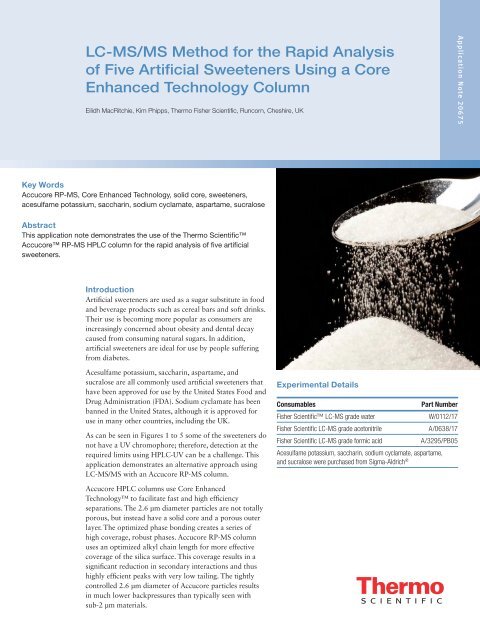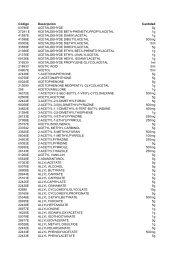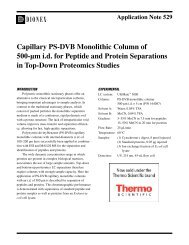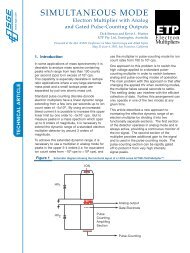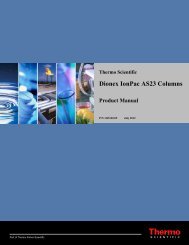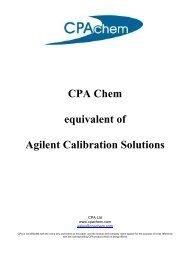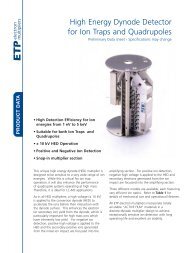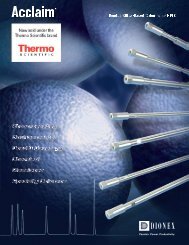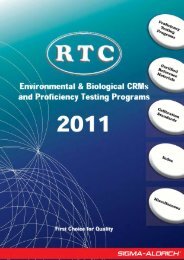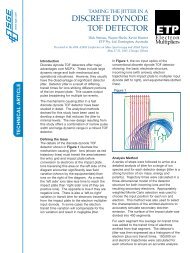LC-MS/MS Method for the Rapid Analysis of Five Artificial ... - Cromlab
LC-MS/MS Method for the Rapid Analysis of Five Artificial ... - Cromlab
LC-MS/MS Method for the Rapid Analysis of Five Artificial ... - Cromlab
You also want an ePaper? Increase the reach of your titles
YUMPU automatically turns print PDFs into web optimized ePapers that Google loves.
<strong>LC</strong>-<strong>MS</strong>/<strong>MS</strong> <strong>Method</strong> <strong>for</strong> <strong>the</strong> <strong>Rapid</strong> <strong>Analysis</strong><br />
<strong>of</strong> <strong>Five</strong> <strong>Artificial</strong> Sweeteners Using a Core<br />
Enhanced Technology Column<br />
Eilidh MacRitchie, Kim Phipps, Thermo Fisher Scientific, Runcorn, Cheshire, UK<br />
Key Words<br />
Accucore RP-<strong>MS</strong>, Core Enhanced Technology, solid core, sweeteners,<br />
acesulfame potassium, saccharin, sodium cyclamate, aspartame, sucralose<br />
Abstract<br />
This application note demonstrates <strong>the</strong> use <strong>of</strong> <strong>the</strong> Thermo Scientific<br />
Accucore RP-<strong>MS</strong> HP<strong>LC</strong> column <strong>for</strong> <strong>the</strong> rapid analysis <strong>of</strong> five artificial<br />
sweeteners.<br />
Introduction<br />
<strong>Artificial</strong> sweeteners are used as a sugar substitute in food<br />
and beverage products such as cereal bars and s<strong>of</strong>t drinks.<br />
Their use is becoming more popular as consumers are<br />
increasingly concerned about obesity and dental decay<br />
caused from consuming natural sugars. In addition,<br />
artificial sweeteners are ideal <strong>for</strong> use by people suffering<br />
from diabetes.<br />
Acesulfame potassium, saccharin, aspartame, and<br />
sucralose are all commonly used artificial sweeteners that<br />
have been approved <strong>for</strong> use by <strong>the</strong> United States Food and<br />
Drug Administration (FDA). Sodium cyclamate has been<br />
banned in <strong>the</strong> United States, although it is approved <strong>for</strong><br />
use in many o<strong>the</strong>r countries, including <strong>the</strong> UK.<br />
As can be seen in Figures 1 to 5 some <strong>of</strong> <strong>the</strong> sweeteners do<br />
not have a UV chromophore; <strong>the</strong>re<strong>for</strong>e, detection at <strong>the</strong><br />
required limits using HP<strong>LC</strong>-UV can be a challenge. This<br />
application demonstrates an alternative approach using<br />
<strong>LC</strong>-<strong>MS</strong>/<strong>MS</strong> with an Accucore RP-<strong>MS</strong> column.<br />
Accucore HP<strong>LC</strong> columns use Core Enhanced<br />
Technology to facilitate fast and high efficiency<br />
separations. The 2.6 µm diameter particles are not totally<br />
porous, but instead have a solid core and a porous outer<br />
layer. The optimized phase bonding creates a series <strong>of</strong><br />
high coverage, robust phases. Accucore RP-<strong>MS</strong> column<br />
uses an optimized alkyl chain length <strong>for</strong> more effective<br />
coverage <strong>of</strong> <strong>the</strong> silica surface. This coverage results in a<br />
significant reduction in secondary interactions and thus<br />
highly efficient peaks with very low tailing. The tightly<br />
controlled 2.6 µm diameter <strong>of</strong> Accucore particles results<br />
in much lower backpressures than typically seen with<br />
sub-2 µm materials.<br />
Experimental Details<br />
Consumables Part Number<br />
Fisher Scientific <strong>LC</strong>-<strong>MS</strong> grade water W/0112/17<br />
Fisher Scientific <strong>LC</strong>-<strong>MS</strong> grade acetonitrile A/0638/17<br />
Fisher Scientific <strong>LC</strong>-<strong>MS</strong> grade <strong>for</strong>mic acid A/3295/PB05<br />
Acesulfame potassium, saccharin, sodium cyclamate, aspartame,<br />
and sucralose were purchased from Sigma-Aldrich ®<br />
Application Note 20675
2<br />
Sample Preparation<br />
The sample was prepared to contain 200 ng/mL <strong>of</strong> acesulfame potassium, saccharin, sodium cyclamate, aspartame, and<br />
sucralose in water.<br />
Separation Conditions Part Number<br />
Instrumentation: Thermo Scientific Dionex UltiMate 3000 RS<br />
system consisting <strong>of</strong> an HPG-3200SD high pressure<br />
gradient pump, WPS-3000 RS <strong>the</strong>rmostatted split-loop<br />
autosampler, and TCC-3000 RS column <strong>the</strong>rmostat<br />
Column: Accucore RP-<strong>MS</strong> 2.6 µm, 50 x 2.1 mm 17626-052130<br />
Mobile phase A: Water + 0.1% <strong>for</strong>mic acid<br />
Mobile phase B: Acetonitrile + 0.1% <strong>for</strong>mic acid<br />
Gradient: Time (minutes) %B<br />
Flow rate: 1 mL/min<br />
Column temperature: 40 °C<br />
Injection volume: 10 µL<br />
0.0 5<br />
0.10 5<br />
1.00 95<br />
1.25 95<br />
1.26 5<br />
2.00 5<br />
Weak injection wash solvent: Acetonitrile / water (20:80 v/v)<br />
Strong injection wash solvent: Acetonitrile / acetone / isopropranol (45:45:10 v/v/v)<br />
<strong>MS</strong> Conditions<br />
Instrumentation: Thermo Scientific TSQ Vantage TM <strong>MS</strong><br />
Ionization conditions: HESI-II<br />
Polarity: Negative<br />
Spray voltage (V): 4000<br />
Vaporizer temp (°C): 450<br />
Sheath gas pressure (Arbitrary units): 40<br />
Aux gas pressure (Arbitrary units): 20<br />
Capillary temp (°C): 300<br />
Collision pressure (mTorr): 1.5<br />
Cycle time (s): 0.02<br />
Q1 (peak width): 0.7<br />
Q3 (peak width): 0.7<br />
Compound Sucralose<br />
Data Processing<br />
Sodium<br />
cyclamate<br />
Acesulfame<br />
potassium<br />
S<strong>of</strong>tware: Thermo Scientific <strong>LC</strong> QUAN TM<br />
Saccharin Aspartame<br />
Precursor ion (m/z) 395.1 178.1 162.0 182.1 293.2<br />
Product ion (m/z) 359.1 79.9 82.0 42.0 261.1<br />
Collision energy (eV) 15 28 16 21 14<br />
S-lens (RF voltage) 120 78 56 79 87<br />
Table 1: Transition details
Results<br />
All five sweeteners were analyzed in less than 1 minute using an Accucore RP-<strong>MS</strong> column as shown<br />
in Figure 6. The retention factor <strong>of</strong> <strong>the</strong> first peak was approximately 2.5. Chromatographic baseline<br />
resolution was not needed as positive identification <strong>of</strong> each individual sweetener was achieved<br />
using <strong>MS</strong>/<strong>MS</strong> detection. Table 2 shows <strong>the</strong> %RSD <strong>of</strong> <strong>the</strong> response <strong>for</strong> all five compounds with less<br />
than 5% RSD illustrating excellent precision.<br />
Compound Retention Time (min) Response %RSD<br />
Acesulfame potassium 0.30 3.8<br />
Saccharin 0.55 3.7<br />
Sodium cyclamate 0.61 4.0<br />
Aspartame 0.76 4.6<br />
Sucralose 0.76 3.8<br />
Table 2: Precision data calculated from 6 replicate injections<br />
Figure 1: Structure <strong>of</strong> acesulfame potassium Figure 2: Structure <strong>of</strong> saccharin<br />
Figure 3: Structure <strong>of</strong> sodium cyclamate<br />
Figure 5: Structure <strong>of</strong> sucralose<br />
Figure 4: Structure <strong>of</strong> aspartame<br />
3


